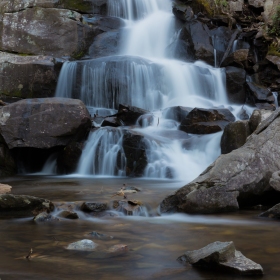
People sometimes move to Knoxville because of the Goldilocks effect. They often start out somewhere like Chicago, Detroit, upstate New York or some other place with a ridiculously long and steep cold season, and move somewhere like Georgia or Florida for some extended warm weather, only to find that down south, they miss having at least a little bit of winter.
So, they come to East Tennessee, or Western North Carolina, to get that “just right” balance between hot and cold weather.

Some of those weather migrants got quite the shock if they moved here recently; Tennessee’s had one of the dreariest, rainiest couple of years on record. So, we wondered, what’s the weather really like around here–historically speaking?
Anecdotal wisdom has it that February can bring some of the bitterest freezes (not least because it’s around the time of year we all start longing for those first flowers to burst forth, and hoping for some short-sleeve weather.) March usually shows up with a snowshower that melts even while it falls, making everything messy and giving us one final snowball fight. August can be ridiculously hot (yes, even by “down-south” standards) and our springs and falls are usually delightfully mild.
But, as the joke is told: “Don’t like the weather in Tennessee? Just stay around five minutes. It’ll change.” Let’s talk about some weather records and averages, quick and dirty.
Coldest temperature on record for Knoxville: December 30, 1917. On this day, negative 32 degrees was recorded at Mountain City. Yes, that’s NEGATIVE. (For reference, the coldest temperature in Knoxville this January, 2019 was 14 degrees. I mean, yeah, that’s cold, but it’s still 46 degrees warmer than negative 32!!!)
Sometimes, in Knoxville, we get complacent. We think winter isn’t all that awful, since we generally get temperatures that range from 30s to 60s, sometimes even balmy 70s in January for a day or two. But this article by the Knoxville History Project proves that a) winter is basically a trickster, figuring out ways to pop up like a grotesque, weathery Jack-in-the-Box, and b) crime doesn’t pay. Especially for the gamblers who tried to steal a steamboat for nefarious activities, only to find themselves completely frozen in place on the Tennessee River for two days!
Enough about winter.
Our summers can be a bit extreme, too, although usually in short (ish) bursts. Our hottest day ever in Knoxville history happened June 29, 2012, when the temperature topped out at 105 degrees. Before that, it was July 12, 1930, at 104 degrees. That’s very, very hot, fellow Knoxville citizens.
And, even though this week in March has been pretty nice: sunny, with temperatures in the 50s and 60s, we’ve had what feels like nonstop rain for months and months. And months, up to now. In fact, knoxnews.com has this little stat for us:
At 17.8 inches on Feb. 26, the 2019 year-to-date rainfall in Knoxville was twice that of the same time in 2018.
Last month (February), we had so much rain that landslides took out roads all over East Tennessee, and we had flooding in some areas of the city and surrounding areas. Kids were even out of school while we had a few days of reprieve from the rain, so waters could recede from side streets. So. Much. Rain.
So, you Goldilocks weather-chasers, the moral of all this is if you don’t like the pleasant, sunny weather we often have here in East Tennessee, just hang out a couple of years. It will change. We are in a temperate rain forest, after all.










